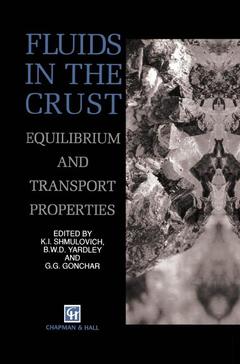Fluids in the Crust, 1995 Equilibrium and transport properties
Langue : Anglais
Coordonnateurs : Shmulovich K., Yardley B.W., Gonchar G.

For much of the 20th century, scientific contacts between the Soviet Union and western countries were few and far between, and often super ficial. In earth sciences, ideas and data were slow to cross the Iron Curtain, and there was considerable mutual mistrust of diverging scient ific philosophies. In geochemistry, most western scientists were slow to appreciate the advances being made in the Soviet Union by os. Korz hinskii, who put the study of ore genesis on a rigorous thermodynamic basis as early as the 1930s. Korzhinskii appreciated that the most fun damental requirement for the application of quantitative models is data on mineral and fluid behaviour at the elevated pressures and temper atures that occur in the Earth's crust. He began the work at the Institute of Experimental Mineralogy (IEM) in 1965, and it became a separate establishment of the Academy of Sciences in Chernogolovka in 1969. The aim was to initiate a major programme of high P-T experimental studies to apply physical chemistry and thermodynamics to resolving geological problems. For many years, Chernogolovka was a closed city, and western scient ists were unable to visit the laboratories, but with the advent of peres troika in 1989, the first groups of visitors were eagerly welcomed to the IEM. What they found was an experimental facility on a massive scale, with 300 staff, including 80 researchers and most of the rest pro viding technical support.
1 An introduction to crustal fluids.- 1.1 Introduction.- 1.2 Fluid systems.- 1.3 Mineral solubility and the composition of crustal fluids.- 1.4 Fluid migration through crustal rocks.- 1.5 Conclusions.- References.- 2 Fluids in geological processes.- 2.1 Introduction.- 2.2 Equilibrium systems with fluid components.- 2.3 Dynamic phenomena in systems with fluid components.- Acknowledgements.- References.- Glossary of symbols.- 3 Hydrothermal experimental techniques used at the Institute of Experimental Mineralogy, Russian Academy of Sciences.- 3.1 Introduction.- 3.2 Parts of the apparatus for studying hydrothermal processes.- 3.3 Sampling techniques.- 3.4 Apparatus and techniques for experiments on diffusion and infiltration metasomatism.- 3.5 Summary and conclusions References.- References.- 4 Solubility and complex formation in the systems Hg?H2O, S?H2O, SiO2?H2O and SnO2?H2O.- 4.1 Introduction.- 4.2 Mercury solubility in water.- 4.3 Sulphur solubility in water and the thermodynamics of the aqueous species Saqo, H2Saq, SO2aq, H2S2O3, HSO4?ine> to 440°C.- 4.4 SiO2 solubility in water and in acid solutions (HCl, HNO3) at 100–400°C and 1013 bar.- 4.5 Solubility of SnO2 in water and aqueous electrolyte solutions at 200–400°C and 16–1500 bar.- 4.6 Summary.- Acknowledgements.- References.- Glossary of symbols.- 5 Experimental studies of the solubility and complexing of selected ore elements (Au, Ag, Cu, Mo, As, Sb, Hg) in aqueous solutions.- 5.1 Introduction.- 5.2 Gold.- 5.3 Silver.- 5.4 Copper.- 5.5 Molybdenum.- 5.6 Arsenic.- 5.7 Antimony.- 5.8 Mercury.- 5.9 Discussion and geological implications.- Acknowledgements.- References.- Glossary of symbols.- 6 The influence of acidic fluoride and chloride solutions on the geochemical behaviour of Al, Si and W.-6.1 Introduction.- 6.2 Gain and loss of rock-forming components during greisenization: an example from the Akchatau W?Mo deposit.- 6.3 Results of mineral solubility experiments.- 6.4 Silicification of rocks associated with acid metasomatism.- 6.5 Conclusions.- Acknowledgements.- References.- 7 The behaviour of components in complex fluid mixtures under high T?P conditions.- 7.1 Introduction.- 7.2 Experimental procedures and techniques.- 7.3 Behaviour of the acid component HCl.- 7.4 Behaviour of the salt components MgCl2, CaCl2 and FeCl2.- 7.5 Concluding discussion.- References.- Glossary of symbols.- 8 Phase equilibria in fluid systems at high pressures and temperatures.- 8.1 Introduction.- 8.2 Binary H2O—salt systems.- 8.3 Ternary systems H2O-CO2—salt systems.- 8.4 Fluid immiscibility and magmatic crystallization.- 8.5 Fluid in metamorphism and anatectic melting.- 8.6 Phenomena accompanying the two-phase fluid state.- 8.7 Conclusions.- Acknowledgements.- References.- 9 Diffusion of electrolytes in hydrothermal systems: free solution and porous media.- 9.1 Introduction.- 9.2 The diffusion of the electrolyte $$ {A_{{{v_1}}}}\,{B_{{{v_2}}}} $$ in dilute solutions.- 9.3 P?T?m dependencies of diffusion coefficients in electrolyte solutions.- 9.4 Theoretical calculations of transport properties of rocks, based on the data on functions of microcrack size distributions.- 9.5 Diffusion of electrolytes in pore solutions: correction for the electric double layer (EDL) effect.- 9.6 Diffusion of NaCl in pore solutions of granite to 600°C.- Acknowledgments.- References.- Glossary of symbols.- 10 Thermal decompaction of rocks.- 10.1 Introduction.- 10.2 Experimental procedure.- 10.3 Results.- 10.4 Discussion.- 10.5 Conclusions: possible geological implications of theeffect of thermal decompaction of rocks.- References.- Glossary of symbols.- 11 Permeability of rocks at elevated temperatures and pressures.- 11.1 Introduction.- 11.2 Key concepts, methods of permeability measurement and experimental procedure.- 11.3 Permeability of magmatic rocks.- 11.4 Permeability of metamorphic rocks.- 11.5 Permeability of sedimentary rocks.- 11.6 Discussion and summary of conclusions.- Acknowledgements.- References.- Glossary of symbols.- Index of aqueous species.- Index of systems.
This book presents the result of experimental and theoretical studies of deep fluids carried out at the Institute of Experimental Mineralogy which has specialized for many years in developing experimental techniques to study deep fluids and mineral solubilities. It provides new results on the transport of electrolyte solutions in rocks at high temperatures. It includes detailed explanations of methods and techniques used in Russian experimental studies, this data is available for the first time.
Date de parution : 09-2012
Ouvrage de 323 p.
15.5x23.5 cm
Thème de Fluids in the Crust :
Mots-clés :
Greisen; carr; formation; metamorphism; mineral; mineralogy; temperature; thermodynamics; transport; water; economic geology
© 2024 LAVOISIER S.A.S.
